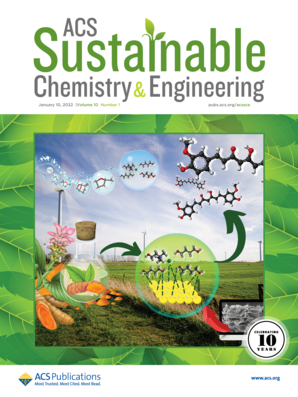MWCNTs/碳布负载共沉积双金属Pt-Pd催化剂作为高效dafc负极材料
IF 7.1
1区 化学
Q1 CHEMISTRY, MULTIDISCIPLINARY
引用次数: 0
摘要
直接甲酸燃料电池(dafc)由于其高理论开路电压(1.45 V)、高功率密度和使用几乎无毒的燃料而成为一种很有前途的便携式设备能源。为了使dafc具有商业可行性,有必要开发一种高效的甲酸(FA)电氧化催化剂。在这里,我们提出了一种基于Pd0.64Pt0.36纳米粒子(Pd0.64Pt0.36 NPs)固定在碳布支撑的MWCNTs表面的纳米结构催化剂。采用线性扫描伏安法(LSV),在动电位条件下,将固定在MWCNTs框架内的PtCl4和Pd(OAc)2前驱体电还原成Pd0.64Pt0.36 NPs。所得到的催化剂形成直径约4 nm的球形NPs,彼此分离良好,并均匀地装饰整个MWCNTs表面。XRD分析表明,催化剂中存在富Pd和富Pt相,而DRIFT测试则清楚地表明,该催化剂具有抗CO中毒的能力,与纯Pd和Pt金属催化剂相比,活性更高。Pd0.64Pt0.36催化剂具有较高的ECSA值(56.94 m2/g)和至少80%的活性位点可用性。这些参数解释了其对FA电氧化的高活性和稳定性。在dafc电池中,温度为60℃,阴极气流为200 mL/min,对Pd0.64Pt0.36催化剂作为阳极的性能进行了评价。在50 mA/cm2负载(14 h)下对3 M HCOOH进行的长期稳定性研究表明,该催化剂具有优异的耐久性。Pd0.64Pt0.36催化剂的dafc在250 mA/cm2下的功率密度值为64 mW/cm2。本文章由计算机程序翻译,如有差异,请以英文原文为准。

Codeposited Bimetallic Pt–Pd Catalyst Supported on MWCNTs/Carbon Cloth as an Efficient DFAFC Anode Material
Direct formic acid fuel cell (DFAFC) is a promising energy source for portable devices due to its high theoretical open-circuit voltage (1.45 V), high power density, and the use of a nearly nontoxic fuel. To make DFAFC commercially feasible, it is necessary to develop an efficient catalyst for formic acid (FA) electrooxidation. Here, we present a nanostructured catalyst based on the Pd0.64Pt0.36 nanoparticles (Pd0.64Pt0.36 NPs) immobilized onto a carbon cloth-supported MWCNTs surface. The Pd0.64Pt0.36 NPs were electrochemically formed under potentiodynamic conditions by using linear sweep voltammetry (LSV) by electroreduction of PtCl4 and Pd(OAc)2 precursors, previously immobilized inside the MWCNTs framework. The resulting catalyst forms ∼4 nm diameter spherical NPs, well-separated from each other and uniformly decorating the entire MWCNTs surface. XRD analysis showed the presence of Pd- and Pt-rich phases, while DRIFT measurements clearly indicate that the catalyst is resistant to CO poisoning and much more active compared to pure Pd and Pt metal catalysts. The Pd0.64Pt0.36 catalyst has a high ECSA value (56.94 m2/g) and at least 80% active site availability. These parameters explain its high activity and stability toward FA electrooxidation. The performance of the Pd0.64Pt0.36 catalysts as an anode was evaluated in a DFAFC cell at a temperature of 60 °C and cathodic airflow of 200 mL/min. A long-term stability study measured under a 50 mA/cm2 load (14 h) for 3 M HCOOH showed excellent durability of the catalyst. DFAFC with a Pd0.64Pt0.36 catalyst shows an excellent power density value of 64 mW/cm2 at 250 mA/cm2.
求助全文
通过发布文献求助,成功后即可免费获取论文全文。
去求助
来源期刊

ACS Sustainable Chemistry & Engineering
CHEMISTRY, MULTIDISCIPLINARY-ENGINEERING, CHEMICAL
CiteScore
13.80
自引率
4.80%
发文量
1470
审稿时长
1.7 months
期刊介绍:
ACS Sustainable Chemistry & Engineering is a prestigious weekly peer-reviewed scientific journal published by the American Chemical Society. Dedicated to advancing the principles of green chemistry and green engineering, it covers a wide array of research topics including green chemistry, green engineering, biomass, alternative energy, and life cycle assessment.
The journal welcomes submissions in various formats, including Letters, Articles, Features, and Perspectives (Reviews), that address the challenges of sustainability in the chemical enterprise and contribute to the advancement of sustainable practices. Join us in shaping the future of sustainable chemistry and engineering.
 求助内容:
求助内容: 应助结果提醒方式:
应助结果提醒方式:


